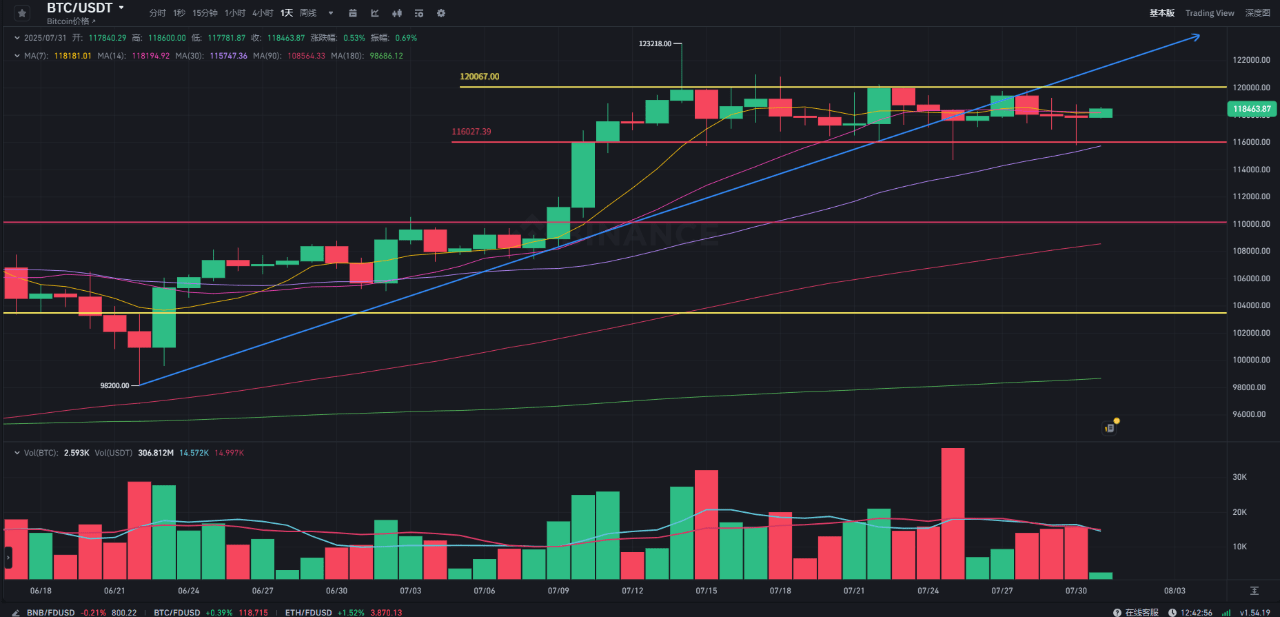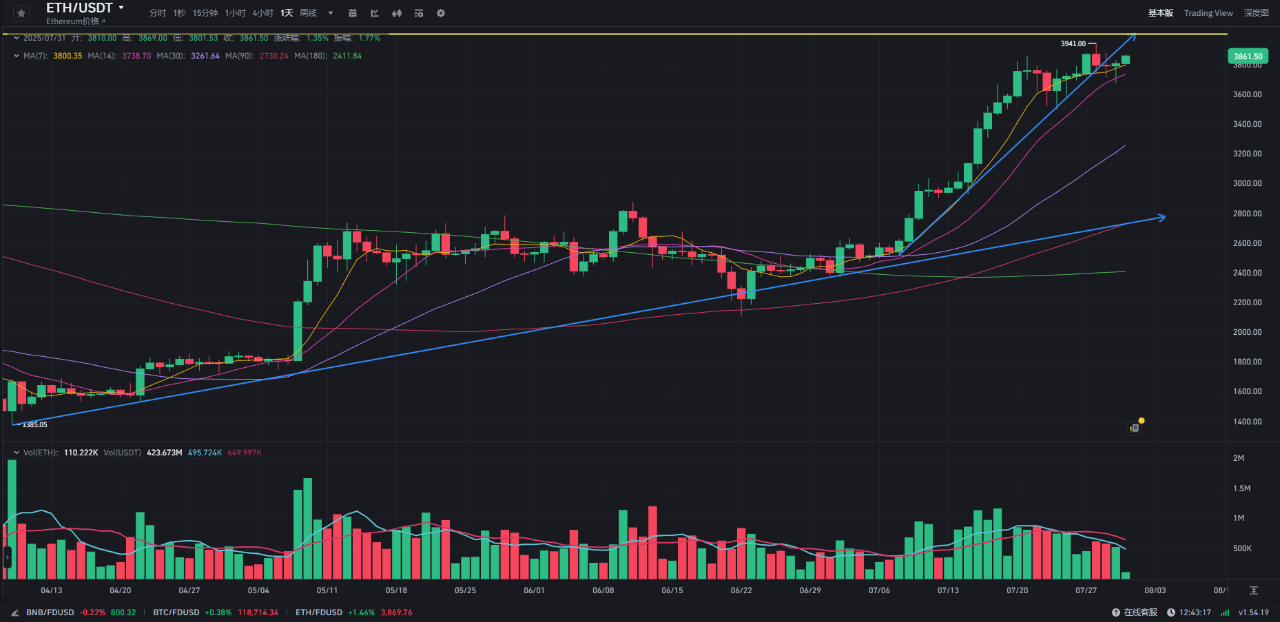August market outlook: Cryptocurrency games under the guidance of Fed policy.

I. Core interpretation of the Federal Reserve's July meeting
Interest rate policy: Extended high-interest rate cycle
The Federal Reserve has kept the benchmark interest rate unchanged at 4.25%-4.50% for the seventh consecutive time, clearly stating that 'higher rates need to be maintained for a longer time' to suppress inflation, completely shattering market fantasies about multiple rate cuts within the year—original expectations were 2-3 cuts, now only retaining the possibility of 'one cut by the end of the year,' contingent on continuous improvement in inflation data. For the crypto market, the high-interest rate environment will continue to suppress the valuation of risk assets, and the trend of capital shifting from cryptocurrencies to low-risk assets like the dollar and government bonds may continue.Economic signals: The 'tug-of-war' between inflation and employment
Core PCE inflation is above the 2% target but is on a downward trend; however, the Fed emphasizes that 'more data is needed to validate the sustainability of the slowdown.' Although the labor market remains strong, there are signs of 'moderate cooling,' with marginal slowing in labor demand. This pattern of 'economic resilience coexisting with policy tightening' has trapped the market in a dual game of 'recession worries' and 'tightening fears,' making it difficult for cryptocurrencies to gain clear directional support in the short term.Risk warning: Multiple uncertainties compounded
The Fed specifically mentioned risks from the Middle East geopolitical situation, fiscal policy swings, and is also concerned about issues like credit tightening, real estate downturns, and declining consumer confidence. These factors may transmit through a 'contraction in risk appetite' to the crypto market, exacerbating price volatility.
II. Trump's tariff policy: Short-term disturbances and long-term concerns.
Brazilian tariffs: A test of 'precise strikes + delayed implementation.'
Trump imposes a 50% tariff on Brazil but exempts multiple industries, with the effective date postponed, showing the 'flexibility' of his trade policy—both signaling protectionism and avoiding severe short-term impacts on the U.S. domestic supply chain. This 'gradual tax increase' may delay market panic, but in the long run, it will still raise import costs, indirectly exacerbating inflation stickiness, which in turn reinforces the Federal Reserve's tightening stance.Tariffs on Canada and Mexico: New risk points approaching
Plans to impose higher tariffs on Canada and Mexico if trade agreements are not reached, which, if implemented, will directly impact the North American Free Trade Agreement supply chain, raising market concerns about 'global trade fragmentation.' Historical experience shows that in the stage of escalating tariff friction, cryptocurrencies like Bitcoin often come under pressure due to heightened risk aversion, necessitating caution against concentrated short-term selling pressure.
III. Mainstream cryptocurrency technical analysis: nearing the end of volatility, direction undecided
1. BTC: The box game is entering its final stage, with volume being key.
After the Fed meeting, Bitcoin briefly broke below the 116K support level but rebounded due to Trump's comments easing tariff concerns, closing the day with a long lower shadow, indicating that buying interest remains around 116K. Currently, it is still within the 116K-120K high-level range, with the MA30-day moving average extending upwards to 116K, and the divergence risk between the K-line and the moving average has been corrected, signaling the end of the consolidation period.

Key signal: Continuous shrinkage in trading volume reflects off-market funds' wait-and-see approach; subsequent confirmation is needed for 'breakout above 120K' or 'breakdown below 116K' to establish direction. The 4-hour chart rebounded after a false break below but lacked sufficient volume, raising doubts about the sustainability of the rebound.
Intraday operations: Focus on short-selling opportunities at the 119K-120K resistance level, with support observed at 116K-117K.
2. ETH: Bullish structure remains intact, but beware of monthly 'upper shadow risk.'
The daily moving averages are in a strong bullish arrangement, showing no deep corrections in the past month, indicating strong bullish control; however, the recent ten-day pattern of 'shrinking volume increases, expanding volume adjustments' exposes short-term profit-taking pressure. After a quick rebound yesterday following a false break below the 14-day moving average, it has regained the 7-day moving average, indicating a strong technical outlook.

What needs to be watched: The monthly chart currently has a 55% solid bullish candlestick, and it is at a key position of the 'three peaks formation.' If today's monthly close shows a long upper shadow, it may indicate the formation of a short-term top. The 4-hour chart's rebound is approaching previous highs, while the 1-hour chart shows signs of stagnation.
Intraday operations: Watch for upper pressure at 3880-3920 and lower support at 3740-3780.
IV. Altcoin market: survival rules in a high-risk environment
As the most risk-sensitive variety, altcoins exhibit characteristics of 'rapid declines and weak rebounds' under the dual pressures of Fed tightening and tariff risks, with instances of daily losses erasing multiple days of gains occurring frequently, exacerbating speculative attributes. Coupled with warnings from multiple regions about 'stablecoin scams,' regulatory tightening further squeezes altcoin liquidity.
Operational principles:
Reject 'bottom-fishing fantasies' and avoid risks of consecutive halving; adhere to 'prioritize escaping peaks,' securing profits is more important than chasing rises.
Stay away from 'long sideways, declining volume stagnation' cryptocurrencies, prioritize targets that 'pull back after starting without breaking key levels,' and ensure a risk-reward ratio of at least 2:1 before entering.
Refer to the 'rolling penetration rotation strategy' (details can be sent privately), focusing on trend tracking rather than subjective predictions to reduce emotional interference.
(Note: This article is only a market dynamics analysis and does not constitute investment advice. Cryptocurrency prices are highly volatile, and entering the market requires careful risk assessment.)#美联储利率决议

